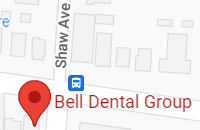The water you drink can be an asset to your dental health.
That’s not just because drinking water washes away food particles that can cause cavities.
Decades of research have shown that an optimal level of fluoride in your drinking water effectively curbs tooth decay. Children had about three times as many cavities before water fluoridation, according to the American Dental Association.
But how does it work? And is it safe for your kids? Read on for more information on fluoride’s role in preventing cavities.
Fluoride isn’t the only thing that can help your family fight tooth decay! Make sure you’re brushing and flossing regularly, and don’t forget your routine dental exams and cleanings.
At Bell Dental Group, we provide high-quality care for the entire family. Give our Cincinnati, OH office a call at 513-802-9440 to schedule an appointment!
How Does Fluoride Prevent Cavities?
Tooth decay occurs as a result of bacterial buildup on and around your teeth. These bacteria feed on the sugars in food debris.
When they process those sugars, they produce a weak acid. This acid eats away at your enamel, the strong, protective outer layer of your teeth.
Fluoride makes your teeth resistant to the acid, which helps keep your teeth healthy. Fluoride can even help reverse some early signs of tooth decay!
Is Fluoride Safe To Drink?
Studies over the past 70 years have shown that water fluoridation is indeed safe, according to the Centers for Disease Control and Prevention. Both the American Academy of Pediatrics and the American Dental Association have said it’s even safe to mix infant formula with fluoridated water.
If consumed at high levels, fluoride can cause fluorosis in children under the age of 8. This condition is marked by changes in tooth enamel, ranging from spots to staining. Children between 15 and 30 months old are most susceptible to fluorosis.
Generally, these cases are mild, and the effect of fluorosis is largely cosmetic. Severe forms of fluorosis are uncommon in the United States but can pose a structural threat to teeth.
However, it’s important to remember that fluoride is an element that in some quantity can be found in all natural water sources, and the amount of fluoride added to water by public utilities is quite small.
In 2015, the U.S. Department of Health and Human Services recommended that water systems maintain a fluoride to water ratio of 0.7 parts per million.
How Do I Know If My Water Is Fluorinated?
Many communities add fluoride to tap water, based on recommendations from the federal government. Your local public water system will be able to tell you whether they add fluoride to the water and, if so, in what quantity.
Greater Cincinnati Water Works does add fluoride to the water, in accordance with state and federal laws, according to its 2016 water quality report.
Not all bottled water contains fluoride, so if your family drinks mostly bottled water, it’s important to check the label.
Similarly, some water filters remove fluoride from tap water, so check with the manufacturer to find out whether that’s the case with your water filter.
Are There Other Ways To Get Flouride?
Yes! All toothpastes that carry the American Dental Association Seal of Acceptance contain fluoride. It has been consistently proven that fluoride toothpastes effectively prevent tooth decay for people of all ages.
It’s recommended that you begin using fluoride toothpaste on your child after they get their first tooth, though it’s best to limit how much you use to a smear of toothpaste the size of a grain of rice. Once the child turns 3, you can increase your use to a pea-sized amount of toothpaste.
Over-the-counter toothpastes have a fluoride concentration ranging from 1000 to 1100 parts per million, but your dentist may be able to prescribe high-concentration fluoride toothpaste (5000 parts per million). These prescription toothpastes are helpful for children at high risk of tooth decay.
At Bell Dental Group, we also offer fluoride varnishes to prevent cavities, which are great for helping young children fight tooth decay (though they’re good for adults too)!
Applying a fluoride varnish only takes a few minutes, and it’s painless. It’s sticky at first but hardens when it’s exposed to saliva. You’ll leave the varnish on for several hours and then brush your teeth to remove it.
Team Up With Us To Fight Cavities
High-quality dental care is one of the best ways to prevent tooth decay. At Bell Dental Care, we’re proud to offer top-notch care for the whole family under one roof.
Whether you’re due for a regular exam or have a restorative or cosmetic dentistry need, we’d be happy to help you! Call us today at 513-802-9440 to schedule an appointment.
Visit Bell Dental Group
We can see you as soon as tomorrow!





